6 Badass Unsung Heroes From History's Darkest Hours
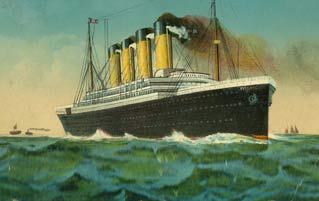
Sometimes, history can look like an endless parade of blood, terror, and unacceptably ridiculous hats. We seem to jump from atrocity to atrocity, only stopping to write books about how terrible our ancestors were before making the same dumb mistakes all over again.
But as we've shown you before, even humanity's biggest shitshows have life-affirming moments hidden within, courtesy of regular people stepping the hell up to help others. Here are six unexpectedly heartwarming stories born out of infamous historical horrors.
Japanese Internment Camps Had Jazz And Swing Bands

When Japanese-Americans were rounded up and forced into prison camps during World War II, they had every reason to do nothing but sit and sulk all day. They'd been branded as enemies of their country exclusively because of their race. However, they couldn't help themselves; as their label indicates, they were still Americans ... and Americans loved the shit out of swing music.

While living in the camps, Japanese-Americans coped however they could, and by far the swingin'-est, most hep method was to pick up an instrument and play. Art Hayashi, a prisoner at Washington State Fair Grounds in Puyallup, WA, became the leader of one of the many swing bands that came together behind the barbed wire fences. These bands ranged from trained professionals like Hayashi and his Harmonaires to kids off the street who figured that relocation gave them the perfect opportunity to learn how to play the saxophone.
Then there was George Yoshida, who upon being forced to move to Poston War Relocation Center in Arizona, was only allowed to carry one suitcase -- so naturally, he filled it with his jazz collection. Yoshida formed a band called the Poston Music Makers, and later told a jazz-ified version of his story through an album titled Big Bands Behind Barbed Wire.

Even for those who couldn't play shit, this gave them a chance to keep their spirits up. People showed off their flair by swing dancing to show tunes (nothing more American than that) and playing songs that suddenly caught a new meaning, like the Manzanar Jive Bombers' version of Bing Crosby's "Don't Fence Me In." To them, music was more than a way to keep from going crazy in prison; it was a statement. The rest of America feared these people as "yellow peril" Axis sympathizers looking to destroy the country, but it turns out they only wanted to destroy our feet on the dance floor.
The Suffragettes Formed A Secret Jiu-Jitsu Fighting Force To Protect Each Other

The suffragettes have, shall we say ... a checkered legacy. On one hand, they kick-started the process which eventually led to women's suffrage and general agreement that, yes, women were members of society. On the other hand, they achieved this through militant methods such as arson, assault, bombings, and vandalism, alongside typical non-crimes such as protesting and disturbing meetings of old white dudes.

Whatever you might think, however, they had an undeniably awesome method for staving off attention from the police: so much jiu-jitsu training that at the drop of a hatpin, they could spin-kick the patriarchy right in the dickhole.
This was all thanks to one member, Edith Garrud. As a seasoned member of the WSPU (Women's Social and Political Union), Garrud was used to watching as her colleagues were beaten, imprisoned, force-fed, and sometimes even killed by the police. She was also a trained practitioner of jiu-jitsu, and thought that it might be time to introduce the art to her friends. They loved it.
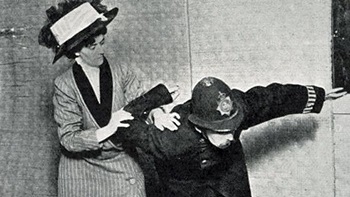
In fact, they loved it so much that some talented individuals were recruited into a secret fighting force known as the Amazons. Their mission was simple: to protect Emmeline Pankhurst, founder of the WSPU, from arrest and probable forced disappearance. Armed with clubs that they kept hidden under their dresses and wearing armor fashioned from cotton and cardboard, the Amazons followed Pankhurst the length and breadth of the country. These weren't empty words, either. When the police sprang a trap at a rally she was attending, her jiu-jitsuffragettes were able to hold off 50 officers in order to allow her successful escape.

The Amazons were disbanded by the WSPU prior to the outbreak of World War I ... or at least, that's what they want us to think. Where do you think the idea for Suicide Squad came from?
The Girl Guides Of Weihsien Made A Concentration Camp Seem Like A Fun Excursion

Whilst we can't speak with absolute authority here, it's safe to say that concentration camps weren't nice places to be. Such a defeatist attitude, however, rules us out of being able to join the elite forces of ... the 1st Chefoo Girl Guides Brigade. During World War II, this plucky group of British youngsters (effectively the Girls Scouts, but with accents) transformed Weihsien Internment Camp into a glorified camping excursion, complete with songs, activities, and (we shit you not) table manners.

First, some backstory. In the 1940s, Imperial Japan was slowly but surely gaining control of China, and every foreigner unlucky enough to be caught inside their borders was put into Weihsien. This included a boarding school full of young children, among whom were the members of the 1st Chefoo Girl Guides. The chirpy interpretation by the troop leader of this event (immortalized in a recently discovered diary) pretty much sets the tone for the next several years:
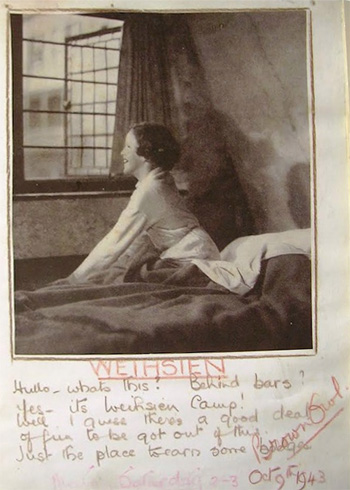
Throughout their stay at Weihsien, the troop was led as if they'd been dropped into some kind of training scenario designed to test their ability to enrich the human spirit. They continued to hold regular meetings, albeit with their roll call now including bits about missing members being moved to another nearby camp. When the troop members were eating their boiled animal grains out of a tin can, troops would be chastised for poor table manners with a curt "There are not two sets of manners, one set of manners for the princesses in Buckingham Palace and another set of manners for the Weihsien concentration camp."
As for other activities, there was drawing, music, and fashioning new blocks of coal from the ashes given to them by the camp's guards. They'd also make new pencils by mixing the shavings with water, as well as regularly race against each other to see who could keep the fire hottest for longest -- little knowing that was the only thing preventing them from freezing to death. Such forced joviality might seem ridiculous, but you know what? It bloody worked.

The whole point of this was to keep people busy, because if not for troop activities, the only other form of entertainment was curling into a ball and softly weeping. So why not treat it like a gamified extension of normal life? And if all the activities make everyone else in the camp feel good, where's the harm? When the camp was liberated by the Allies in 1945, the girl guides were credited as a major morale booster. Some of their pupils are still alive, and you know, if they wanna start a singalong or something right now, we're game.
A Small Town Sorts Through The Wreckage Of A Bombed Airplane, Lovingly Restores The Victims' Personal Items

Imagine you're a citizen of the small Scottish town of Lockerbie, and one day in 1988, hundreds of pieces of metal, random objects, and body parts come raining out of the sky -- a Pan Am airplane carrying 259 people was blown up over you in a terrorist attack, killing all occupants plus 11 bystanders. How would you react? If you didn't say, "By screaming endlessly, curling up in the fetal position under my bed, then moving the hell out of town," then you're braver than us.


Well, the actual townspeople of Lockerbie didn't have time to panic. They were too busy diving into the wreckage to collect any personal items they might find. No, not to keep them or sell them on eBay (again: '80s). Simply to comfort the victim's families.
In order to store the tens of thousands of debris pieces that had been scattered over 845 square miles, the first thing the townspeople did was build a warehouse. From scratch. Any items that weren't of forensic value were left for them to organize. But they couldn't hand them to the bereaved families looking all ugly, no. They had to make them presentable. Working as a gigantic assembly line of washers and dryers and ironers and folders, the townspeople restored the countless items of clothing scattered across the charred, muddy, usually quite apocalyptic landscape. They developed rolls and film and put diaries back together to identify the owners, while any stray rings, wallets, and other effects were carefully matched up to the corresponding suitcase. In one instance, the State Department informed one family that they couldn't have their daughter's stuff back because it was "too badly damaged." The people of Lockerbie scoffed at that and un-damaged it.
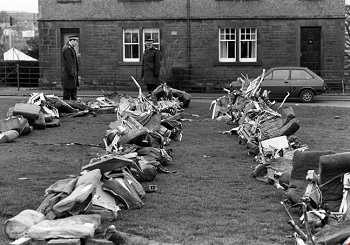
When relatives flocked to Lockerbie in order to be near to the site of the crash, the town opened its doors and took them in, setting the foundation for friendships that still survive today. Christmas cards are exchanged, letters are written, and families still journey to the town. It takes a lot of awesome to turn a town from "giant crater where my loved one died" to "place of friendship and comfort."
The German Judge Who Tried To Take Down The Nazis With Corruption Charges

Georg Konrad Morgen was a judge in the SS judiciary -- think the NCIS for Nazis. Though a high-ranking Third Reich official, he was basically the guy in the office who won't stop giving you shit about using too much tape. In fact, he managed to achieve through sheer bureaucratic needling what was impossible any other way at the time: making Nazis answer for their crimes.

Before he started his quest to throw sand into the works, Morgen was already a thorn on Heinrich Himmler's side. Immediately after being assigned to Krakow (and after presumably scratching his vibranium balls), the judge went after Himmler's inner circle for their corrupt ways. He threw charge after charge at Himmler's future liaison to Hitler, Hermann Fegelein, forcing Himmler to step in again and again for his pal. Himmler got sick of this and threw Morgen into a soldier's uniform on the Eastern Front ... only to call him back, because he was so damn good at his job. Morgen's new assignment? SS corruption in concentration camps.
It was there that Morgen got his first good look at the real Reich. After receiving a package deemed suspicious by the Post Office and customs for its weight, Morgen opened it up to find three lumps of crudely smelted dental-quality high-carat gold. His job as an inspector and a judge required no more of him than to arrest and sentence the sender, but he wanted to see for himself how the hell gold teeth from about 100,000 mouths ended up on his desk. He went to Auschwitz and demanded a tour of the facilities ... and got it. Morgen was absolutely appalled. He knew they were Nazis, but he didn't know they were, you know, Nazis.
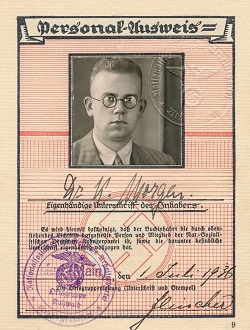
Morgen couldn't make the SS answer for their crimes against humanity, but he could make them answer for their crimes against the law. He had the power to wield red tape like a saber, and he used it to interfere as much as he could with the party he no longer wanted to belong to. He was able to arrest Gestapo chief Maximilian Grabner and brutal Buchenwald commandant Karl Otto Koch for killing prisoners and corruption. Again, during goddamn Nazi Germany.
Grabner turned out to be too big a fish to catch, but Koch stayed on the line and was eventually executed. Morgen then played a huge role in the trials of war criminals following the end of World War II, describing what he had seen and uncovered during his time as the most persistent bureaucrat ever. And true to his title, he wasn't doing the right things for the right reasons; he just loved the law and wanted the system (that is, the Third Reich) to be free of corruption. Gotta have some standards, you know?
Father Thomas Byles Voluntarily Stayed On The Titanic To Absolve Passengers' Sins

Thomas Byles was the much-loved reverend at the very British parish of Chipping Ongar and Doddinghurst. His parishioners loved him so much, in fact, that when he was asked to officiate at his brother's wedding in New York, they even helped pay for his boat trip. The boat? A brand-new ocean liner called Titanic.
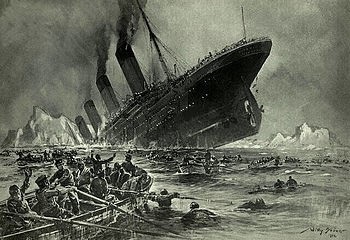
Instead of kicking back and enjoying the ride, though, Father Byles kept doing his job ... right until the end. One morning, Byles said Mass for the second-class passengers, telling them about "spiritual lifeboats that take us to God." Unfortunately, that information would come in handy later that same day, when the ship began to sink.
At this point, the priest reportedly had plenty of chances to leave on a lifeboat, but he turned them down. Instead, he helped others get to safety and made his way toward the stern, where over a hundred people were trapped. There, he heard their confessions and performed their last rites even as the water rose around them. We're pretty sure that if the iceberg that killed him had come over and asked for forgiveness, Father Byles would have absolved it.

In the end, Father Byles sacrificed his life to save others and to give comfort to a panicked group of passengers of various creeds and religions. Pope Pius X declared him a martyr when his bereaved family visited the Vatican, and there's currently a movement to declare him a saint. We declare it a sin that there's no James Cameron movie about this guy.
When they aren't dishing out puns and vigilante justice, Marina and Adam can be found on Twitter. Adam also a Facebook page!
Also check out 5 Inspiring Acts Of Kindness By Terrifying Crime Syndicates and 6 True Stories That Will Restore Your Faith In Humanity.
Subscribe to our YouTube channel, and check out 5 'Game Of Thrones' Plotlines Ripped Right Out Of History, and other videos you won't see on the site!
Follow us on Facebook, and we'll follow you everywhere.